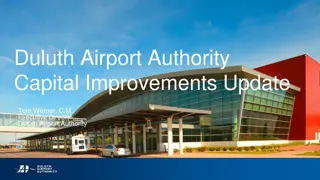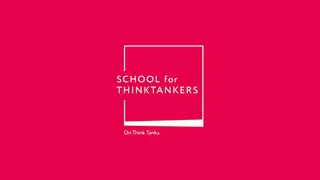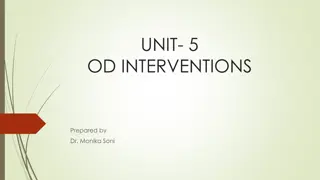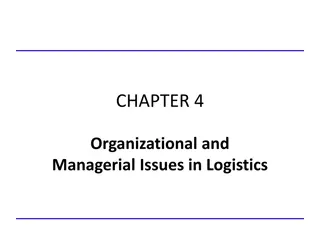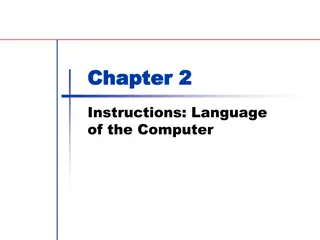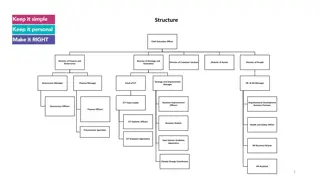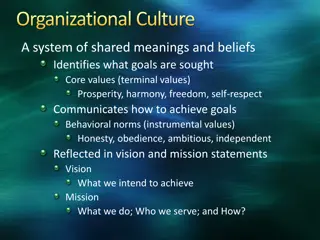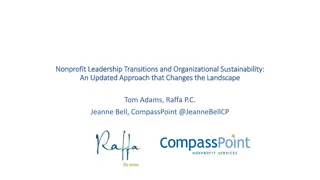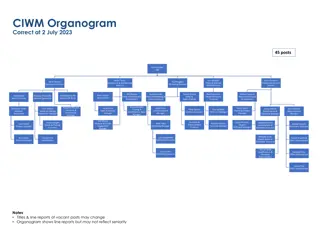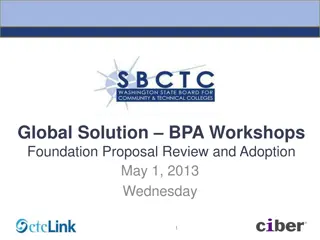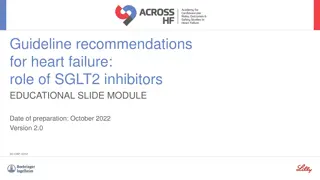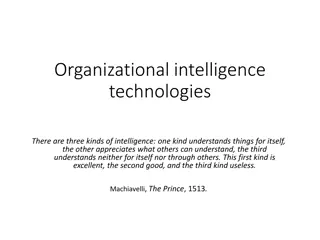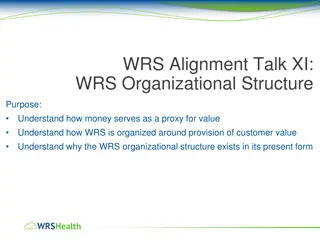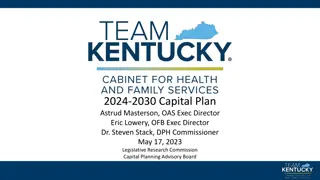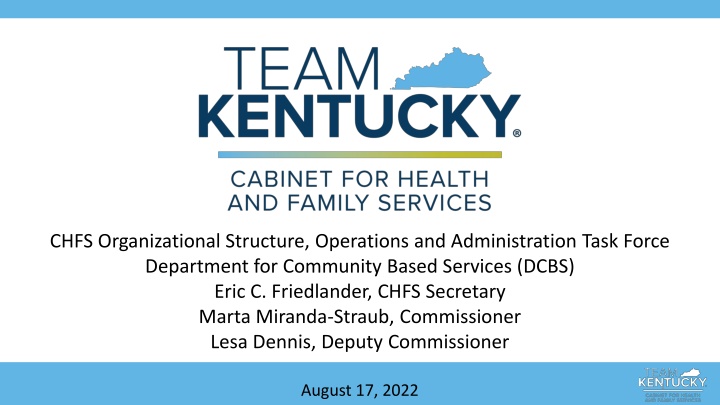
CHFS Organizational Structure & Operations
DCBS, part of CHFS, delivers services to enhance family self-sufficiency, improve safety, & engage community partners. It comprises over 4,000 state employees across Kentucky, with detailed overviews of personnel, expenditures, and programs administered. A snapshot of the structure, finances, and services provided by DCBS is presented.
Download Presentation

Please find below an Image/Link to download the presentation.
The content on the website is provided AS IS for your information and personal use only. It may not be sold, licensed, or shared on other websites without obtaining consent from the author. If you encounter any issues during the download, it is possible that the publisher has removed the file from their server.
You are allowed to download the files provided on this website for personal or commercial use, subject to the condition that they are used lawfully. All files are the property of their respective owners.
The content on the website is provided AS IS for your information and personal use only. It may not be sold, licensed, or shared on other websites without obtaining consent from the author.
E N D
Presentation Transcript
CHFS Organizational Structure, Operations and Administration Task Force Department for Community Based Services (DCBS) Eric C. Friedlander, CHFS Secretary Marta Miranda-Straub, Commissioner Lesa Dennis, Deputy Commissioner August 17, 2022 1
DCBS Overview DCBS Overview DCBS is responsible for delivering services to families to enhance the self- sufficiency of families, improve safety and permanency for children and vulnerable adults, and engage families and community partners in a collaborative decision-making process. DCBS provides services related to child care, child and adult maltreatment prevention and protection, child and caregiver supports, and public assistance. Service is enhanced through a close relationship and coordination with community partners. DCBS is comprised of over 4,000 state employees across every county of Kentucky. 2
DCBS Personnel DCBS Personnel Over 4,000 total DCBS employees: 4,065 full-time employees 112 interim employees 3
Organizational Structure Organizational Structure 4
DCBS SFY 2022 Expenditures by Fund DCBS SFY 2022 Expenditures by Fund $11,958,778 $72,691,152 $542,906,740 $946,739,409 Total $1,574,296,078 Federal General Restricted Tobacco 5
DCBS SFY 2022 Expenditures by Class DCBS SFY 2022 Expenditures by Class $468,017 $492,960,419 $1,033,801,865 $47,065,777 Total $1,574,296,078 Personnel Costs Operating Expenses Grants, Loans, & Benefits Capital Outlay & Projects 6
DCBS SFY 2022 Expenditures by Program DCBS SFY 2022 Expenditures by Program $10,142,145 $37,646,338 $158,603,084 $25,757,275 $470,830,168 $130,299,234 $125,392,648 $47,835,984 $197,525,825 $370,263,376 Total $1,574,296,078 SNAP Medical Assistance State Supp TANF LIHEAP Child Care Family Based Services Adult Services Alternatives for Children Other 7
Snapshot of Programs Administered by DCBS Snapshot of Programs Administered by DCBS Eligibility determinations for Medicaid and health insurance affordability options Supplemental Nutrition Assistance Program (SNAP) State Supplementation Program for persons who are aged, blind, or have a disability Temporary Assistance for Needy Families Block Grant (KTAP, KY Works Program, supportive services) Child Care Assistance Program (CCAP) Low Income Home Energy Assistance Program (LIHEAP) Child maltreatment prevention Child protective services Foster care and adoption Chafee Foster Care Independence Program and Educational and Training Vouchers Community Services Block Grant (CSBG) and standards for Kentucky s Community Action Network Family Violence Prevention and Services Grant and regulation of state- funded domestic violence shelters Adult protective services, general adult services, and alternate care services Designation of the state rape crisis centers and children s advocacy centers Regulation of day care, private child care, and domestic violence batterer intervention providers Child care provider professional development and quality-rating system 8
Division of Protection and Permanency (DPP) Division of Protection and Permanency (DPP) DPP is responsible for policy development, oversight of contracts, training/consultation, stakeholder engagement and quality assurance activities including, but not limited to: Programming and policy related to foster care and contracted childcare and child placing providers Meeting outcomes related to safety and behavioral health of adults and children Stakeholder engagement strategies that meaningfully include impacted communities and youth s voice in decision-making Expansion of prevention services (moving to Division of Prevention and Community Well- being) Supportive Services for current and former foster youth. 9
Statewide: Children in the Custody of or Statewide: Children in the Custody of or Committed to the Cabinet Committed to the Cabinet June 2016 June 2016 June 2022 June 2022 10,500 10,047 10,000 9,500 9,000 8,500 8,684 8,000 7,894 7,500 7,000 6,500 1 0 6,000 Source: Foster Care Fact Sheets Feb-17 Jun-17 Jun-18 Jun-19 Jun-20 Jun-21 Jun-22 Jun-16 Feb-18 Feb-19 Aug-19 Feb-20 Feb-21 Feb-22 Aug-16 Aug-17 Aug-18 Aug-20 Aug-21 Dec-16 Dec-17 Dec-18 Dec-19 Dec-20 Dec-21 Oct-16 Oct-17 Oct-18 Oct-19 Oct-20 Oct-21 Apr-17 Apr-18 Apr-19 Apr-20 Apr-21 Apr-22 10
REPORTS THAT MET ACCEPTANCE CRITERIA FOR REPORTS THAT MET ACCEPTANCE CRITERIA FOR CHILD ABUSE/NEGLECT ASSESSMENT CHILD ABUSE/NEGLECT ASSESSMENT SFY 2020 SFY 2020 SFY 2022 SFY 2022 2020 2021 2022 6000 5000 4000 3000 2000 1000 0 Jul Aug Sep Oct Nov Dec Jan Feb Mar Apr May Jun 11
Child Protective Services (CPS) Intakes Child Protective Services (CPS) Intakes SFY 2020 SFY 2020 SFY 2022 SFY 2022 2020 2021 2022 123,567 121,673 140,000 109,611 107,423 103,276 98,518 120,000 96,978 85,712 83,759 100,000 80,000 50,707 40,230 38,574 60,000 40,000 14,306 11,768 11,396 9,485 9,353 7,601 20,000 0 All Intakes (excludes APS) All CPS Response Intakes Intakes w/ Allegations of CA/N Reports that Met Acceptance Criteria (Screened In) Reports w/ a Substantiated or Services Needed Finding Reports w/ a Substantiated Finding 12
Prevention Prevention 13
Division of Family Support Division of Family Support Medical Support and Benefits Branch supports DCBS field staff in the interpretation and clarification of Medicaid policy and procedures. Family Self-Sufficiency Branch provides resources and technical support to field staff in the implementation of programs funded under TANF (Kentucky Transitional Assistance Program, Kentucky Works Program, Family Alternatives Diversion, Relocation Assistance Program, and Work Incentive Program). Policy Development Branch centralizes the policy development and oversight functions for Family Support programs including TANF, SNAP, LIHEAP, CSBG, and State Supplementation. Program Integrity Branch monitors claims in SNAP, TANF, and Medicaid programs statewide. Nutrition Assistance Branch is responsible for SNAP policy and procedures on eligibility and providing technical assistance to field staff. 14
Community Services Block Grant Community Services Block Grant (CSBG) (CSBG) CSBG is a federal grant that supports local initiatives to eliminate poverty. The supports are based on local needs such as rent and mortgage assistance, utility assistance, or childcare stipends. DCBS has a partnership with Community Action Kentucky, Inc. to provide services for all 120 counties through 23 local Community Action Agencies. 151,611 households received CSBG assistance in SFY 2021. 15
Division of Child Care Division of Child Care 2,010 active child care providers (licensed, certified, and registered) 30,005 children (16,672) families enrolled in the Child Care Assistance Program (CCAP) Increased CCAP provider reimbursement rates twice recently: July 2021 increased with appropriated General Funds October 2021 increased with American Rescue Plan Act (ARPA) funds Using ARPA funds to support providers: Sustainability payments to providers Business partnership start-up grants Child care desert start-up grants Family child care start-up grants Facility repair grants Providing for child care teacher credentialing This Photo by Unknown Author is licensed under CC BY-SA-NC 16
ARPA ARPA- -Funded CCAP Expansions Funded CCAP Expansions Implemented a 3-month transitional period for households exiting the program due to exceeding income limits (50% payment rates) to address the benefits cliff Increased initial CCAP eligibility threshold twice recently: January 2022 from 160% of Federal Poverty Guideline (FPG) to 200% of FPG July 2022 from 200% of FPG to 85% of State Median Income 17
Data From Recent Changes Data From Recent Changes Increasing initial eligibility Eligible Because of FPG Change = No Eligible Because of FPG Change = Yes Total Number of Distinct Cases Number of Distinct Cases Children Count Month - Year Number of Distinct Cases Children Count Children Count Jan-22 1,763 3,132 212 313 1,975 3,445 Feb-22 1,037 1,892 140 219 1,177 2,111 Mar-22 1,159 2,098 132 186 1,291 2,284 Apr-22 1,117 2,057 154 224 1,271 2,281 May-22 1,101 1,952 138 204 1,239 2,156 Jun-22 763 1,457 96 147 859 1,604 Grand Total 6,940 12,588 872 1,293 7,812 13,881 Implementing transitional exit Affected By 3-Month Transitional Program Category April May June Total Family/Children Count # of Children 15 21 20 56 # of Families 10 15 12 37 18
Implementing Employee Child Care Assistance Implementing Employee Child Care Assistance Partnership (ECCAP) Program Partnership (ECCAP) Program Creating a public and private partnership pilot program to incentivize employers to contribute to the child care cost of its employees, per House Bill 499 (2022 Regular Session) Holding peer-to-peer calls with other states Promulgating administrative regulation and standardized contract Begin accepting applications April 2, 2023 Payments issued beginning July 1, 2023 19
Designed within a culture of safety through the infusion of primary and secondary prevention initiatives Phase I: Stabilization (6 months) Phase II: Innovation (18 months) Phase III: Thriving (3 year plan) 20
Building a 21 Building a 21st st Century DCBS The Vision The Vision Century DCBS Robust in person and virtual workforce Open concepts Flexibility work/life balance Review, revise, and modernize all the features and physical conditions in which DCBS work is performed Incorporating lived experience trusted advisors council A living example of who we are as an agency and what and who we value 21
Building a 21 Building a 21st st Century DCBS The Challenge The Challenge Century DCBS Continuous exposure to multiple traumatic events High risk positions similar to EMS and police Toxic stress, burn out, vicarious trauma, and compassion fatigue Secondary Post Traumatic Stress Disorder Quality of services is diminished Work capacity/retention/turnover Trauma triggers the desire to leave the work 22
DCBS Challenges DCBS Challenges Workforce Turnover Workforce Turnover 2020 DCBS total 12.93% Social worker front line classifications: 29.60% Family support front line classifications: 28.50% 2021 DCBS total 20.41% Social worker front line classifications: 40.44% Family support front line classifications: 29.14% 2022 DCBS total for January June 7.88% Social worker front line classifications 21.76% Family support front line classifications 12.57% 23
DCBS Staff Exit Reasons DCBS Staff Exit Reasons 2019-2021 top reasons listed for separation from DCBS: Better job outside of state government, retirement, insufficient pay, too many cases, lack of promotional opportunities, career change, family reasons/responsibilities Reasons for DCBS Separations, 2020 30 25 Number of Respondents 20 15 10 5 0 Unsatisfactory Work Pay School Benefits Relocation Too Many Cases Recognition Career Change Health - Personal or Supervisor not challenging Inadequate Training Early Retirement Job Incompatibility Standard Retirement Better Job: Outside Better Job: Within Better Job: Self- Unsatisfactory Promotional Commute Family 24
DCBS Challenges DCBS Challenges High Acuity Youth High Acuity Youth High acuity youth refer to children in DCBS custody that present with needs for intensive behavioral health issues; sometimes paired with physical health issues. Likely to be an adolescent Likely to be committed for dependency Likely to have multiple failed placements and treatment episodes Common factors include: Aggression to self, others, or property Intellectual disability or autism Co-occurring physical health conditions Problematic sexual behaviors 25
Case Description of a High Acuity Youth Case Description of a High Acuity Youth 14 y/o female with a history of 3 treatment courses for a brain tumor 3 out-of-state placements for treatment - returned prior to completion for all 2 episodes where out-of-state facility returned child to Kentucky and was boarded at Norton Children s emergency room for 10+ days each episode Severe, long-term sequalae: Intellectual disability Endocrine problems Need for oncology follow up Behavioral problems 26
High Acuity Youth Continued High Acuity Youth Continued Children experiencing a mental health crisis may be kept in emergency department facilities, boarded until they can be admitted into a psychiatric treatment program or transferred to another facility. Boarding keeps children safe but does not provide the specialized mental health treatment kids need to help them recover. Experienced in other states as well: Children at Connecticut Children s Hospital wait on average 7 days for an inpatient bed Seattle Children s reports youth can wait up to 2 weeks for an inpatient bed 27
High Acuity Youth Continued High Acuity Youth Continued In June 2022, 467 children were referred for placement and 119 (25%) had no acceptances 28
Steps Taken to Address This Issue Steps Taken to Address This Issue Clinical Services Branch Enhanced payments Community partnerships UofL Peace Hospital, churches, state parks Regional leadership identifying appropriate placements for youth ready to be in the community Workgroups and committees TLC High Acuity Youth, SIAC Service Array Standing Committee, Custody Relinquishment Workgroup Working with AETNA on SKY 29
Questions Questions 30

